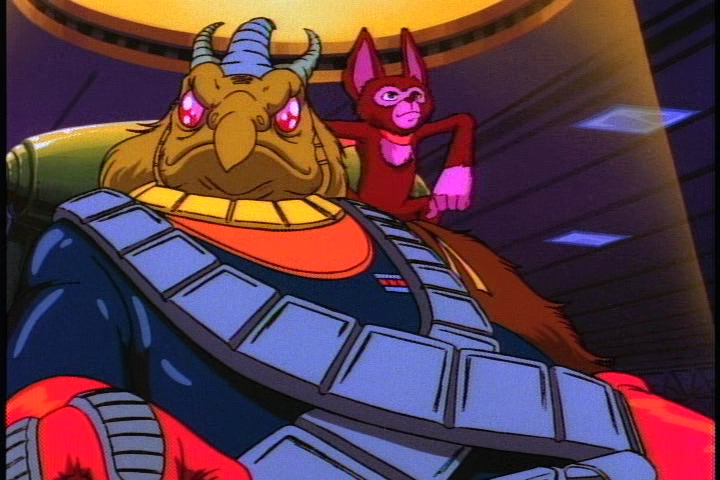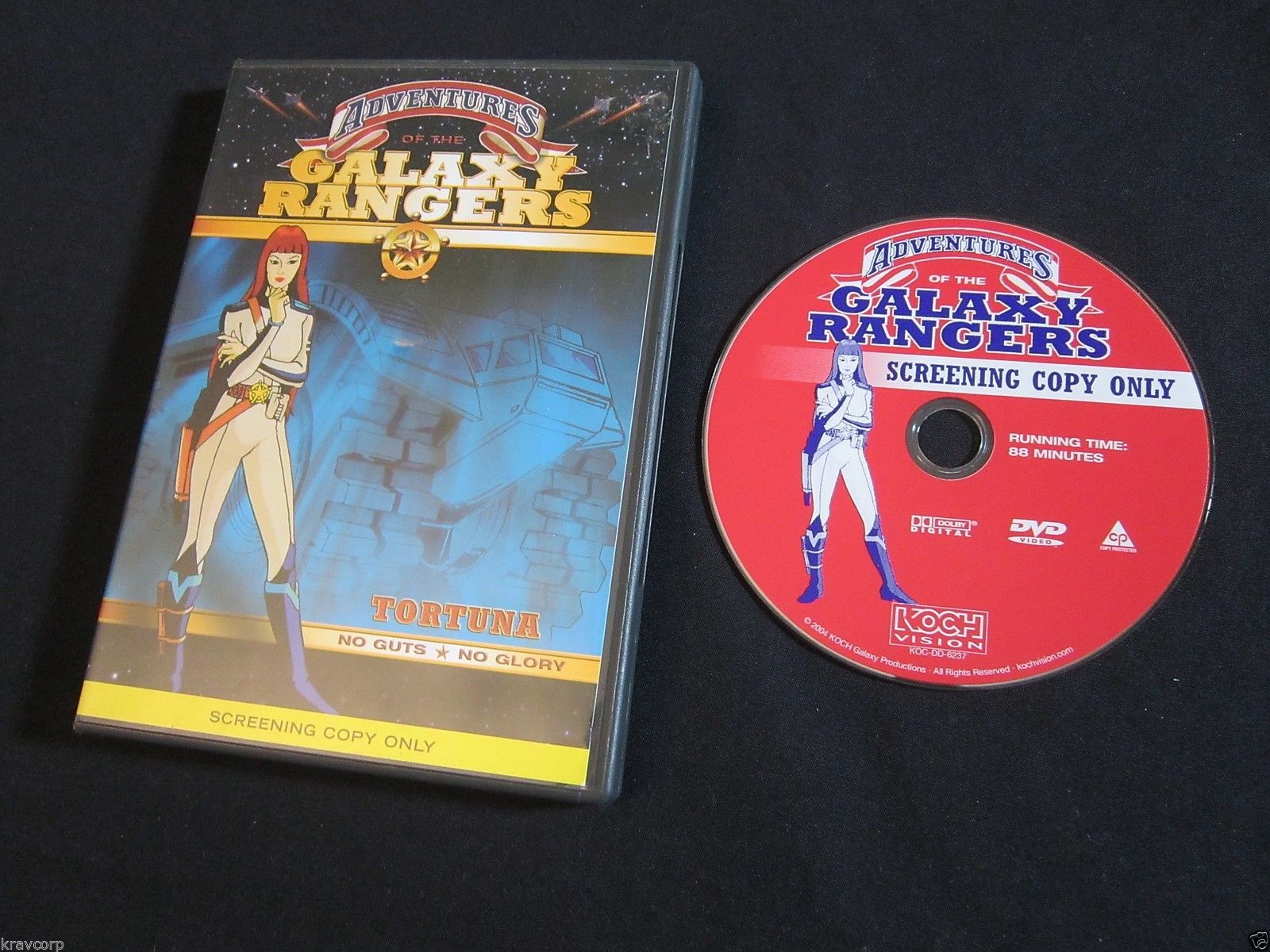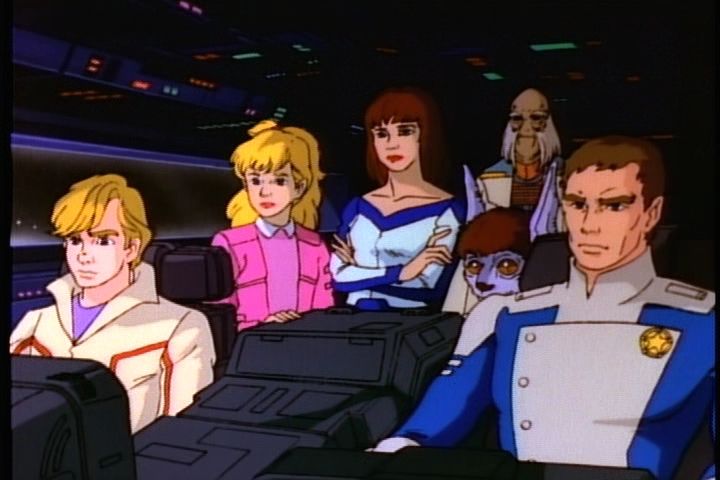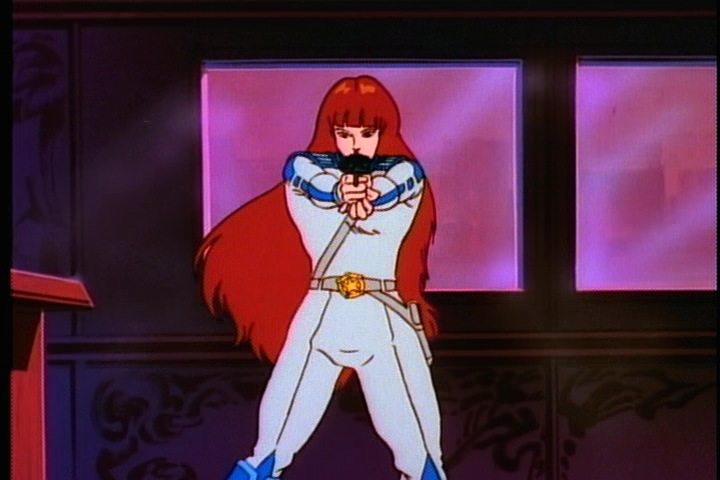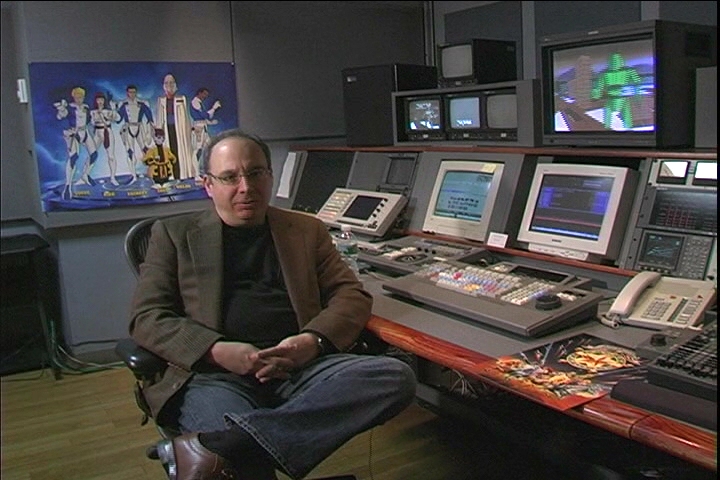ADVENTURES OF THE GALAXY RANGERS: No Guts, No Glory
From Betamountain.org
In 2086, two peaceful aliens journeyed to Earth, seeking our help. In return, they gave us the plans for our first hyperdrive, opening the doors to the stars. We have assembled a team of unique individuals to protect Earth and our allies. Courageous pioneers, committed to the highest ideals of justice, and dedicated to preserving law and order across the new frontier. These are the adventures of the Galaxy Rangers.
In 1984, Robert Mandell had an idea—to create a space western, an animated series which would be a MAGNIFICENT SEVEN for the after-school set.

The setting was Earth, but the feel was definitely more 1880s than 1980s, with the final frontier very much the wild west frontier of the United States. When two alien ambassadors arrive on Earth's doorstep, seeking new allies to stop the encroaching attacks of a crumbling empire lead by a Queen (voiced by SPEED RACER veteran Corinne Orr), the Bureau of Extra-Terrestrial Affairs (BETA) creates the Rangers—law men (and women) to safeguard Earth and her allies from the Crown. Using simulacra powered by the life-force of sentient beings channeled through a "psycho crystal", the Queen (barely) maintains her far flung empire. When she discovers how powerful an energy source the new players in the game—humans—can be, the Crown begins rounding up human settlers, among them a BETA commander's wife.
The core cast was comprised of four Texas Rangers in space: Commander Zachary Foxx (Jerry Orbach), a by-the-book officer who suffered personal tragedy that put his wife in a coma, prompting the formation of the team. Shane Gooseman (Doug Preis), a maverick cowboy who was the only survivor of a failed genetic experiment designed to create the ultimate soldier. Walter "Doc" Hartford (Hubert Kelly), a computer hacker and self-styled ladies man, and Niko (Laura Dean), a psychic raised on the hidden world of Xanadu by her mentor, Ariel.
This show had it all. Rock and roll, land rushes, sword and sorcery, talking dolphins (which sounds much cheesier than it actually was—mostly), the sexiest lady outlaw ever drawn (Daisy O'Mega, of the Black Hole Gang) —and plenty of fantastic space battles on a par with the original STAR WARS trilogy. Each of the characters had distinct personalities and strengths and flaws, with stories often growing out of those conflicts, rather than relying on the Aliens-of-the-Week to supply the plots.

Sometimes confused with similar space westerns (Filmation's BRAVESTARR and World Events Productions's SABER RIDER AND THE STAR SHERIFFS, which was the re-packed and re-written Japanese series SEI JUSHI BISMARK), GALAXY RANGERS has a devout cult following, with fans anxiously awaiting the upcoming DVD release in October.
Series creator and producer Robert Mandell recently took time out of his busy schedule to dish with fans about the origins of the GALAXY RANGERS, and their potential future.
|
It's been almost 20 years since you started—are you ever surprised that there's this strong a cult following? |
|
|
You started developing it in '84, and it went on the air in '86—was it really just a year and a half of hardcore production? 11 months of actual hardcore production. It was about a year and a half of selling and getting financing, and contracts and everything else together. We had some very talented people on RANGERS. We were very lucky. Not only the writers, but the designers and the graphic artists. It was a good team, and the only reason why we wanted to do it in New York was because there wasn't a lot of animation being done there, and we had the pick from thousands of artists and craftsmen who wanted to work on a show like this who couldn't get to LA to work with the bigger studios. |
|
|
Who did the character designs for the show? Was it a team of artists? It was a team of artists, but Eddie Lee was really the key guy on the characters. Eddie was a genius when it came to characters. The hardware was Ray Shenusay. |
|
|
Was it difficult getting the production mounted, without a toy deal? Very difficult. The only thing was to get it going was the promise of them bringing in a toy deal. In the 80s, that was the age of toy-driven financed animation. It started with HE-MAN in the early 1980s and that really opened the gates. Once HE-MAN was such a success for Mattel, all the toy companies decided it was cheaper to produce TV programming than it was to buy advertising time, so they combined it and made the TV program the advertising. During the late 1980s, I did a lot of work with Griffen-Bacal, through the TRANSFORMERS and MY LITTLE PONY years. Then afterwards, I worked very closely with Hasbro on another show called PRINCESS GUINEVERE. Even then, the toy companies were very powerful, although in the mid 1990s, the toy company programming began to fade away and now it's almost non-existent. So much has changed in the last 20 years, in terms of how the media works and how the business works, itself. But in the 1980s, it was really toy-financed animation. That's how you got the bulk of the financing to produce the show, and that's how you secured your time-slots on the TV stations, because the toy companies would guarantee a certain amount of advertising for the local stations. The more advertising the stations got, the more eager they were to keep your show on the air. When we went on the air in '86, we had no toy company support and we had a very small distribution company handling the show. So we couldn't back up our station line-up with a guarantee of advertising dollars because we had no toy company. So a few months down the road, the ratings were not that good starting out, and the stations started moving us around and putting us in worse time-slots, and our distributor couldn't demand the better time-slots. So it was unfortunate, coupled with the fact that the content of the show was a little bit ahead of its time. During the production, I got a lot of flack from the distributor, who kept saying 'This is not what we wanted. We wanted something much more traditional. Every Rangers has got to be in every episode, doing the same thing.' And we just used to say 'Well, what fun is that?' The more they pushed me to do something more 'traditional', the more I went in extreme directions. But at the same time, we were trying to do the action, and trying to keep it light, and we did some funny episodes—some of the funny stuff really worked, actually. |
|
|
Did you ever run into any of the problems with the content? For example, on G.I. JOE, every time a plane exploded, you saw a little guy parachuting to safety. But on RANGERS, when those interceptors blew up—those guys were dead. We didn't really have any Standards & Practices, because we weren't really producing for a network. We had our own guidelines that we had developed. We didn't show any overt violence on RANGERS, but it was certainly a lot tougher than some of the other shows of the time, like G.I. JOE and THUNDERCATS and more of the "softer" action. A lot of our action was based on comic action, and a lot of our writers were raised on comic books and I was too. In our attempt to be different from everything else on the air, we went—obviously the story-lines and the characterizations were somewhat deeper, but we also went for a lot more comic book style visualizations and I think having TMS Studios on-board as our animation partner made all the difference in the world. They were the best, and the still are the best. They added a tremendous amount of intensity to the show. |
|
|
Whose idea was it to combine the CGI graphics with the hand-drawn animation? Because that was quite unique, for its time. We had done that on a show previous to GALAXY RANGERS. Prior to RANGERS, I did a show called THUNDERBIRDS 2086 which was more of an import. It was designed to be a co-production with a Japanese company—Fuji Television. It ended up being produced for the Japanese market and I ended up taking it and Americanizing it here. But in the process of Americanizing it, we threw in a whole bunch of computer graphics we had done on the Atari computer. We were fooling around with it, we decided that would be fun to do that. It looked pretty cool. We took some of the computer frames from the animation and we just matted in the graphics, and it was relatively simple and very cost-effective, and when RANGERS came about we upgraded the computer somewhat, but the intent was still the same. When [the characters] look at computer screen or see something created by a computer. Then it was taken a step further, where we figured 'Hey, if there are actually computer generated characters on the screen, why don't we just generate computer generated characters?' So it seemed to fit, story-wise. |
|
|
What do you think was probably your favorite episode that you worked on that really stands out as a great example of the range the show had, and the strength of the writing? It was no question it was Tom DeHaven's shows. Tom DeHaven at the time was a major writer, and still is. A novelist. And Tom wrote three episodes. I tried to get him to do more, but he just didn't have the time. 'Galaxy Stranger' which was everybody's favorite episode. He also wrote 'One Million Emotions' which started out as a typical sort of police episode, and ended up being a lot more, with a lot of depth and a lot of great characterizations, and the third one he wrote was 'Rainmaker' which also had a lot of emotion and drama and great dialogue. So those three are some of my favorites, because he really got it. He was a great writer. If you read those scripts, it doesn't matter that it's animation. It's just great stories and great characters, and great situations. They're very compelling. The fact that it was animation was just a bonus because you could do things visually that back then you couldn't do in live action. Brian Daley was in a league by himself. Brian was great. We all loved Brian very much, and it was devastating when he passed away. But Brian did some great episodes. Brian did 'Supertroopers,' 'Armada', and 'Smuggler's Gauntlet' were all some really good ones. |
|
|
When you guys were writing those scripts, had you known from the beginning the connections between Gooseman and Commander Walsh? Or was that something that came up during the pitch process that just seemed to fit? It just seemed to fit. It evolved. [The script] is the first process. Being a producer, I think that the script's not finished until the show's finished. The closer you get on the script, the easier it is. The storyboarding process is really like finishing the script. You make changes, laying it out visually. So much of the scripting evolved because we were moving very fast, and we had broad stroke ideas of where we wanted the characters to go, and we never could complete the story arc because we just ran out of time, and by the end we just had to really jam—there were a number of episodes where we had to just make it up as the episodes came back. Something like 'Tortuna Rock' was made up in post, because we had no story. It was funny, it actually turned out pretty well. But out of the 65 episodes, I think there are a good 45 really, really strong half-hour shows. Very strong. By that I mean really well-crafted episodes. All of the art form, the techniques that go into the making of a well-crafted show—the editing, the music, the scoring, the acting, direction, writing. It's all there. You can see that. It's quality stuff. That's still the reason why RANGERS has stood the test of time, because a lot of effort put into making sure it was quality on all those levels of craftsmanship. A lot of other shows at the time were done along the lines of being disposable entertainment. Just throwing in what the toy companies wanted. |
|
|
Did you have a favorite character, out of the core cast? Me myself? Probably Geezie. The Pedulont? Yeah, of course. First of all, my brother did the voice. My mother would kill me if I don't hire my brother, whenever I do a production. Second of all, who else could I push for 18 hours a day? The others I had to pay. And Geezie was a very peculiar character because a lot of his dialogue was noise, so you needed an actor who could sit there and make noise. We used to make a lot of noise, growing up together, so I knew what kind of noises I could expect from him. |
|
|
The practice of having the voice cast loop in the dialogue in ADR to the finished animation—did that ever cause any production problems in terms of trying to match the lip-flaps and make the delivery natural? With any other dialogue director, it probably would have. But we had the best—and he still is the best. Peter Fernandez is probably the best ADR director I've ever met, and he actually worked with my father before I got in the business, looping European films. Peter was the voice of Speed Racer. So because we had so little time—the production was on a very accelerated schedule, we decided to do temp tracks up front, and again I'd get my brother it sit in the studio and read everything. We'd send those in, and when we got the animation back, we decided to do motion-picture style looping. The advantage to that was that the actors could see the actual footage and could add all these nuances and details that we normally couldn't ahead of time. The downside is, that the actors had to loop. So it was difficult for some. It was Jerry Orbach's first [voice acting] experience ever with animation. But he came from a movie background, so he knew about looping, and he was very good at it. He was in and out very quickly. The others had some trouble, but I think the advantages far outweighed the disadvantages because the performances benefited from seeing the footage. |
|
|
Were the recording sessions done all in New York? Or was it all voice-patched and put together in post? It was all New York. Jerry was in New York at the time, and the rest of the actors were all New York-based. I think the decision was made to try and do everything differently on GALAXY RANGERS. We didn't want typical animation voices, we didn't want typical animation writers, we didn't want the typical animation studio. Everything was designed to be something that we all thought was very cool, and I guess we had a different level of what was cool—the perception of 'cool'—than Hannah Barbara did. |
|
|
I think that the fact that series like BRAVESTARR have sort of disappeared in the mists of time, and yet there's still dozens of RANGERS fan websites online proves you succeeded in creating something "cool." We had fun doing it, and like everything else that I work on, I understand the creative process intimately—that's what I do for a living. If you're not having fun and you're not enjoying it yourself, you can't expect anyone else to. When we made GALAXY RANGERS, we had a great time doing it. We really loved what we were doing. We loved the stories, we loved the characters, and we thought we were being very entertained while we were doing it. And so I figured, well, if we're entertained, then someone out there, someone else is going to be entertained. Someone else is really going to like this. And it did find its audiences. I think it would have found its audience a lot earlier if the timing had been different. We were just a little ahead of its time, and I think what's happen now is very exciting. We have finally made a deal with Koch Entertainment to release the DVDs, and they're allowing me to do all the remastering, which is great. So I'm going back to the original masters as far back as I can get, and all this new technology exists today for upgrading the video, and we're going back and re-mixing the sound tracks into 5.1 stereo. It's really the ultimate RANGERS viewing experience. And the video looks just amazing. It looks better than it ever did, and not many people got to really see it in pristine form. No one could have ever foreseen DVDs, and no one knew 20 years later that television series on DVD would be the most popular item ever produced. It's amazing, what it's done to the DVD business. |
|
|
Will the discs feature any commentary or extras? Not upfront. What Koch is doing is that they're trying to get the series out in the marketplace relatively inexpensively so that people will buy them. So they're putting four episodes on a disc at $14 a piece, and they're going to seed the market with that, and then the next year they go into a full collector's set with all 65, and that will have a lot of commentary and lots of my personal RANGERS stuff that I've collected over the years. Sales trailers, storyboards, artwork, and then the plans are we're going to do a new RANGERS DVD. That's what this is all about. I'm convincing Koch to market this old stuff, and it's great to put it out there and get everybody familiar with it. And thank God they're letting me do the remastering. But the big picture here, the real goal is to do something new. |
|
|
Brand new ADVENTURES OF THE GALAXY RANGERS? Of course! Why Not? Whether we do a series of DVDs, or a new series, I don't know. We'll see how it goes. I think that we certainly could pre-sell a DVD movie. I'd much rather produce a direct-to-DVD feature because you have much more control. Dealing with the studios is just a pain in the neck, the more money involved. The RANGERS as a DVD movie could be terrific. We can do a lot more, you get more bang for the buck on a DVD movie. And of course, 20 years later, the potential for animation is tremendous. What we can do these days... I don't know what techniques we'd use, but I'm sure we could find some integration of 3-D and 2-D. You don't see a lot of the tradition 2-D animation anymore. Everybody's trying to do the latest new 3-D look and stuff. I have Chris Rowley now doing some story outlines for me, so if all goes well and the discs sell well, we'll be in production on a direct-to-DVD RANGERS feature which would be very exciting. |
|
|
What would it be about? I think it's really going to be Niko and Goose, 20 years later, sort of like their UNFORGIVEN. They're living together somewhere, and we bring in a new series of young Rangers who have to go out and find them and bring them in because they have to get pulled back into the action. I'm very excited about that. We always wanted to follow-up and finish [the Eliza Foxx arc]. And we wanted to follow, obviously, the Supertrooper story. Everyone loved that story. Gooseman and the Supertroopers. It was a very Western idea, that Gooseman had to go out and become a bounty hunter and bring in his fellow supertroopers. That's probably the story-line we want to pick up for the new movie, just because it was so great. The Niko story—we never really got too much about Niko's background, other than the one episode 'Ariel.' Everybody loved that episode, and we never really got a chance to follow up that story. Niko was a great character. I think ahead of her time. |
|
|
I loved the fact that the token girl had a great big shotgun, and could kick your ass. You didn't want to mess around with her! |
|
|
So, what's next on your plate? I'm working on a feature now—the RINGWORLD feature. The rights have been optioned, and I'm working with one of my best friends who's actually producing it. His name is Bill Todman. He's an excellent producer. I'm also in the publishing business currently. We're doing a book series—the most successful one is for tween girls, which is called Avalon: Web of Magic. We just sold our millionth book. It's doing very, very well. It's geared for 8-12. It's more high fantasy than urban fantasy. There are three girls, lead characters, each very different, and they get involved with protecting an animal preserve that's home to these magical animals. We're in book 11 of the series, and we're contracted for 18 books. |
|

References
- ↑ The interview was originally posted at MediaSharx and can be viewed via Archive.Org: http://web.archive.org/web/20050207112435/http://www.mediasharx.com/index.php/features/3378
- ↑ It is also posted at one of (if not the) longest running GR sites out there http://www.loony-archivist.com/rangers/mandell.htm and has been reposted here with permission.











